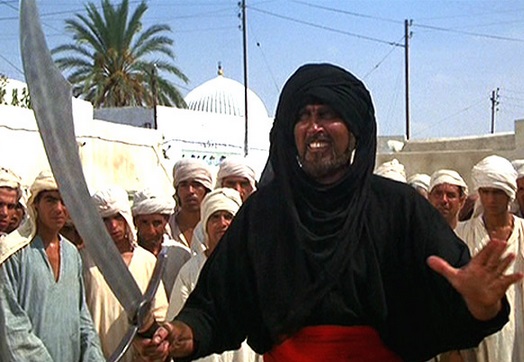  |
 |
 |
 |
|
MahdiWatch.org
|
 |
|
Home | About Me | Links to My Articles | Info on My Books | Contact Me
|
 |
|
Welcome to MahdiWatch.org! NEWSFLASH! COMMENTS LINK
BELOW EACH POST IS ENABLED! FEEL FREE TO BURY ME, PRAISE ME--OR JUST ISSUE A PERSONAL FATWA!
al-Mahdi is "the rightly-guided one" who, according to Islamic Hadiths (traditions),
will come before the end of time to make the entire world Muslim. Over the last 1400 years numerous claimants to the
mantle of the Mahdi have arisen in both Shi`i and Sunni circles. Modern belief in the coming of the Mahdi has
manifested most famously in the 1979 al-`Utaybi uprising of Sa`udi Arabia, and more recently in the ongoing
Mahdist movements (some violent) in Iraq, as well as in the frequently-expressed public prayers of former Iranian
President Ahmadinezhad bidding the Mahdi to return and, in the larger Sunni Islamic world, by claims that Usamah bin Ladin
might be the (occulted) Mahdi. Now in 2014 Mahdism is active in Syria, as the jihadist opposition group Jabhat al-Nusra
claims to be fighting to prepare the way for his coming; and in the new "Islamic State/caliphate" spanning
Syrian and Iraqi territory, as its leadership promotes the upcoming apocalyptic battle with the West at Dabiq, Syria. This site will track such Mahdi-related movements, aspirations, propaganda and beliefs in both Sunni and Shi`i
milieus, as well as other Muslim eschatological yearnings.
For a primer
on Mahdism, see my 2005 article, "What's Worse than Violent Jihadists?," at the History News Network: http://hnn.us/articles/13146.html; for more in-depth info, see the links here to my other writings, including my book on Mahdism.
|
|
|
|
Monday, December 23, 2013
Mahdi Is Just All Wrong For Thee
Just in time for the Christmas season
comes this heart-warming tale from the “Dhaka [Bangladesh] Tribune:” “A self-proclaimed pir (religious preacher), who claimed himself to be Imam Mahdi, his son
and four disciples were slaughtered in a house…last evening.” Lutfor Rahman “had long been claiming…to be Imam
Mahdi as well as the last Nobi [sic] (Prophet) and his residence [had come] under attack several times by extreme Islamists”
from organizations like Shahshantantra Andolan, Khelafat Andolan, Khelafat Majlish and Islami Oikya Parishad. A local high-ranking police official—ironically named
Mehedi [Mahdi] Hasan, said that Rahman had been arrested at least three times by police, and jailed once, in recent years
for his Mahdist claims and for “hurting religious sentiments.” Rahman was also said to have
disseminating leaflets stating that he was the Mahdi. His recompense for this: being tied up, mouth
taped, and killed by fellow Muslims in an unspecified manner (although I'd wager blades were involved).
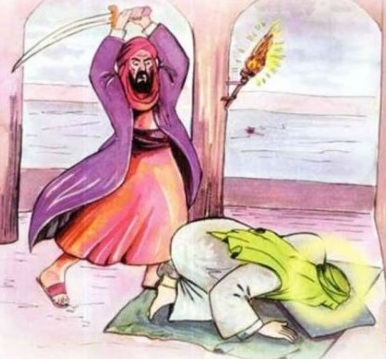
Obviously this Mahdi has ingested plutonium--so I must perform radical surgery!
Observations:
1) While
I often blog on the dangers that Mahdism presents to others—especially in macro terms, as evidenced by numerous examples
of such movements from Islamic history—this is the micro, flip-side thereof: claiming to be the Mahdi
can be hazardous to one’s health. (For two prominent 20th century examples of unsuccessful Mahdism
being a death warrant, take a look at the case of the failed Turkish Mahdi of 1930 and, more famously, the Mahdist revolution manque in 1979 Saudi Arabia.)
2)
Pir is a Persian term for a Sufi shaykh. I don’t know Bengali, so perhaps the term in Bangladeshi
Islam has lost its mystical connotation and simply means—as the article translates—“religious preacher.”
But I suspect Sufism is involved here, knowing that historically the Islamic mystical orders are the primary ground
whence Mahdism sprouts.
3) The primary opposition to Lutfor Rahman’s self-styled Mahdist da`wah came from political
Islamic groups, notably ones interested in resurrecting the caliphate (“Khelafat”). These were
almost certainly fundamentalist Sunni, as Bangladesh’s 150 million population is 89% Muslim, and of that the vast majority
(95% or so) is Sunni. It’s possible that Rahman was part of the small minority of Shi`a; but, on
the contrary, he may have been Sunni—since Sunni Mahdism is quite prevalent in Islamic history (as per my book).
4)
Once again, a major news organ in a predominantly-Muslim country demonstrates ignorance of basic Islamic doctrines and history,
in stating that belief in the Mahdi is the province of “a sect of Muslims.” No, such belief
is mainstream across space and time in the Islamic world—although articulation thereof is, obviously, fraught with danger in modern Islam.
5) Contrast the violent retribution meted
out to Mahdist pretenders with that directed at false Christs in the Christian world. Men like Alan John Miller and Apollo Quiboloy, far from being eradicated, can build up movements and, presumably, make a comfortable living via messianic pretensions—whereas
Mahdist poseurs are little t0lerated in the ummah. The two major reasons for this, of course are
that: Islamic political thought still does not draw a line between the religious and the political—so a claim in the
former realm threatens the latter order; and Islamic societies are simply far less tolerant than Christian ones, whether the
issue is messianism, atheism or homosexuality.
11:24 am est
Tuesday, December 17, 2013
Mahdism: It's Not Just for Muslims (and Evangelicals) Anymore
Not all those
who wander onto my website are lost, I realize; but many seem a bit confused about my religion (Christian--conservative
Lutheran division; NOT Muslim or even Evangelical Christian), and my aims with Mahdiwatch (to
analyze Mahdism and Islamic eschatological beliefs as geopolitical issues which the West needs to consider and possibly counter--not
shoehorn them into the book of Revelation). Perhaps the following brief eschaton-centric CV will help visitors
to this site better grasp my perspective (especially if they're looking for a guest lecturer on such topics!):
Doctoral Dissertation (Ohio State University, 2001): “Eschatology as Theory, Eschatology as Politics: Modern
Sunni Arab Mahdism in Historical Perspective” using Arabic sources (274 pp.)
Published Works:
Holiest Wars: Islamic Mahdis, their Jihads and Osama bin Laden (Greenwood, 2005)
“A
Western View on Iran’s WMD Goal: Nuclearizing the Eschaton, or Pre-Stocking the Mahdi’s Arsenal?,”
Institute for Near East and Gulf Military Analysis , Special Report No. 12, January 2011
“The Modern Impact of Mahdism and the Case of Iraq,” chapter in Political Islam from Muhammad
to Ahmadinejad (Praeger, 2009), pp. 182-192
“Appearance or Reappearance? Sunni Mahdism in History and in Theory and Its Differences from Shi`i
Mahdism,” in Imam Mahdi: Justice & Globalization (London: Institute of Islamic
Studies, 2004), pp. 113-131
“Bin Ladin: The Man Who Would Be Mahdi,” Middle East Quarterly, Vol. IX, No. 2 (Spring 2002),
pp. 53-59
“Islam[ic Eschatology],” Encyclopedia of Millennialism and Millennial Movements (2000), pp.
187-92
“Islamic Eschatology and Politics since 1967,” Institute for the Study of Islam in the Modern
World Newsletter, Vol. IV (December 1999), p. 22
“Ibn Khaldun on the Mahdi,” Journal of the Association of Graduates in Near Eastern Studies,
Vol. VII, No. 1 (Fall/Winter 1997), pp. 16-22.
Online/Popular
Works:
“The Ideology Behind the Boston Marathon Bombing,” History News Network [HNN], April
22, 2013
“Mahdism (and Sectarianism and Superstition) Rises in the Islamic World,” HNN, August 13, 2012
“Nowhere Man: The Islamic World Is At Your Command,” HNN, May 5, 2011
“Iran’s New Mahdism Da`wah Video: Letting Slip the Jinns of Jihad?,” HNN, April 4, 2011
“Dueling
Messiahs: Jesus v. the Mahdi in Iran,” “The Lutheran Witness,” Feb. 2009
" The Importance of being Mahdist: Among Iran’s Twelvers,” “The Weekly Standard,” Sep. 8, 2008
“Will Iraq Stokes Flames of Islamic Messianism?,” PJ Media, April 7, 2008
“Enter the Mahdi,” Review of Trofimov, The Siege of Mecca, “The Weekly Standard,”
Feb. 25, 2008
“Islamic Unity: Bin Ladin’s Version v. Khameini’s,” HNN, Sep. 10, 2007
“Symposium: Ahmadinejad’s Armageddon,” Frontpagemag, Sep. 4, 2006
Lectures/Conference Presentations:
"Does Fiver + Sevener = Twelver?
Iranian Mahdist Da`wah among the Zaydis of Yemen and the Isma'ilis of Saudi Arabia," Truman Center, Haifa University
(Israel), November 2013
“After the
End of the World: Modern Christian and Muslim Views of Post-Apocalyptic History,” Southeast World History
Association “The Ends of the World” Conference, Georgia State University, Atlanta, GA, October 2012
“Mahdism and Violent Apocalyptic Threats in Islam,” Monterey Institute of International Studies,
“Doomsday Threats, Real and Imagined,” Monterey, CA, July 2012
“Islamic
History and Eschatology: An Overview,” Defense Institute of Security Assistance Management, Wright-Patterson Air
Force Base, Dayton, OH, June 2012
"Eschatology in the Middle East since 9/11,” Concordia University-Irvine, CA, September 2011
“Modern Worldviews, Activites and Trajectories of Iraqi Millenarian Groups,” CENTRA Technology,
Arlington, VA, April 2011
“Shi`i Eschatology and the Iranian Vision: Awaiting the Return of the
Mahdi,” Ethics & Public Policy Center/Hudson Institute, Washington,
DC, June 2010
“The Importance of Being Mahdist: The Islamic Republic of Iran, Geopolitics and Jihad,” School of
Advanced Military Studies, Ft. Leavenworth, KS, February 2009
“Through a Glass Darkly: A Comparison of Past Mahdist Movements to the Shi`i Ideal of the Eschatological
Mahdist State Yet to Come,” Fourth Annual Mahdism Conference, Tehran, Islamic Republic of Iran, August, 2008
“The Strategic Implications of Islamic Messianism and Shi`i Jihad for US Policy,” U.S. Army War
College, Carlisle Barracks, PA, April 2008
“The Modern Impact of Mahdism and the Case of Iraq: The Return of Shi`i Jihad,” Association for
the Study of the Middle East and Africa [ASMEA], Washington, DC, April 2008
“Acting Like It’s the End of the World: The Role of Eschatology in the Islamic World Today,”
Rice University, Houston, TX, March 2007
“The Eschatological Struggle of Ahmadinejad, Nasrallah and Bin Ladin,” Southeast Regional Middle
East and Islamic Studies Seminar, Valle Crucis, NC, Oct. 2006
“Modes of Muslim Jihad: Mystical, Fundamentalist, Messianic,” Georgia Political Science Association,
Savannah, GA, Nov. 2005
“Blogging for the Mahdi: Muslim Eschatological Cybercommunities,” “Muslims’
Experiences of Globalization,” Georgia State University, Atlanta, GA, April 2005
“Challenging Pax Islamica: Mahdist Rebellions against Islamic States,” “Pax et Imperium—Dream
or Delusion: Empires and Imperialism in World History?,” Southeastern World History Association,
University of Alabama-Huntsville, 2004 “Mahdist Invocations from Ibn Tumart to Usama bin Ladin,” Islamic Da`wah, Ben
Gurion University of the Negev, Beersheva, Israel, 2003
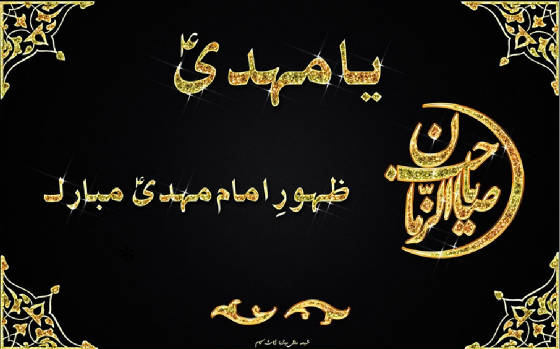
"Ya Mahdi:" Wonderful Artwork by Iktishaf.
Sunday, December 15, 2013
Domes of the Rock and Chain v. A Dome of Iron: Which Best Protects Israel from Islamic Attack?
Over Thanksgiving I spent eight days in Israel, having been invited there by my friend Dr. Moshe
Terdiman, founder of the think-tank “Research on Islam and Muslims in Africa.” I lectured at the Truman Center of Hebrew University on “Iran’s Global Da`wah—Focus on Africa” and at the Ezri Center for Iran and Persian Gulf Studies, Haifa University, on “Does Five Plus Sevener Equal Twelver? The Shi`a of Yemen and Arabia and their
Relationship to Iran.” Also, on Thanksgiving Day (November 28) I delivered the keynote
address, “Sufis v. Salafis in Islamic Africa,” at the first (hopefully hereafter annual) “Islam in Africa”
conference held in Israel and attended by several Israeli ambassadors to various African countries, as well as the ambassadors
of Nigeria, Ethiopia, Kenya, South Africa and Ghana to Israel. When
not working, I had four days to investigate the Old City of Jerusalem. Although I had been there twice
before (2003 and 2007), this trip was uniquely interesting in a number of way. First, compared to
my first two trips, there were many, many more African Christians (Nigerians and Ghanaians, in particular) on pilgrimage.
Possible reasons might include: the growing wealth of Africans; greater awareness of transnational
Christianity on their part; easier access (both from home and by the Israelis) to Jerusalem; increasing piety among African
Christians; or some combination thereof. A countervailing trend was the presence of many more Muslim women
wearing the niqab (face-covering) and burka (body-covering), not simply the hijab (head and chest
covering)—proving that even in Israel the idea that Islam al-hall, “Islam is the solution,” continues
to gain in popularlity. Most
importantly, I was finally able, at last, to gain access to al-Haram al-Sharif, known to Jews and Christians as the
Temple Mount; and although I could not access Qubbat al-Sakhrah, the “Dome of the Rock,” I was at least
able to get close and take pictures as well as explore the area around it (in the meagre hour allotted for “infidels”).
One of the most fascinating edifices which is accessible to Christians and Jews is Qubbat
al-Silsilah, the “Dome of the Chain” immediately to the east of the Dome of the Rock: 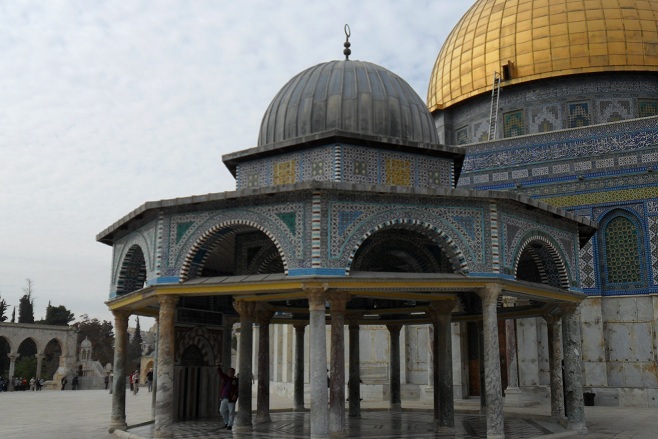
Dome of the Chain, in front of the famous Dome of the Rock.
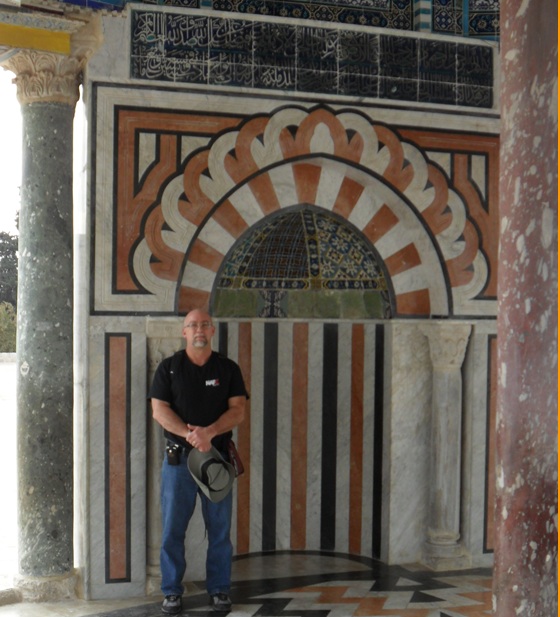
Yours truly inside the Dome of the Chain. Thankfully no infidels were harmed in the taking
of this picture. My prior visitation means that on Judgment Day I will get to cut to the front of the line!
When I got back home, I researched this strange structure,
mainly via a superb, scholarly article by Gülru Necipoğlu, entitled “The Dome of the Rock as Palimpset: `Abd al-Malik’s Grand Narrative and
Sultan Süyleman’s Glosses” from Muqarnas, Vol. 25 (2008), pp. 16-105. According
to Necipoğlu, even before the building of the Dome of the Rock the Umayyad caliph Mu`awiya “propagated the use
of the term ‘land of the Gathering and Resurrection [on the Day of Judgment]’ (ard al-mahshar wa ‘l-manshar)
with regard to Jerusalem” and he “furthermore attempted to extend Jerusalem’s sanctity to the entire province
of Syria-Palestine (al-sham), the locus of his capital, Damascus.” Mu`awiya “thus
established a precedent for identifying the holiness of the sanctuary in Jersualem with cosmology, eschatology, and the legitimization
of dynastic caliphal authoriity….” (Necipoğlu, p. 19). The later Umayyad caliph `Abd
al-Malik had built the Dome of the Rock before he died in 705 AD as well as, most probably, the Dome of the Chain, constructed
“on the site where David [was said to have] judged the Children of Israel by means of a chain of light suspended between
heaven and earth….which could distinguish those who were speaking the truth in legal disputes from those where were
lying [and which was] withdrawn to heaven when a disputant attempted to trick it. The same tradition identifies
the Dome of the Chain as the place where the Prophet [sic] encountered the maidens of Paradise at the time he was miraculously
transported to Jerusalem on his Night Journey.” 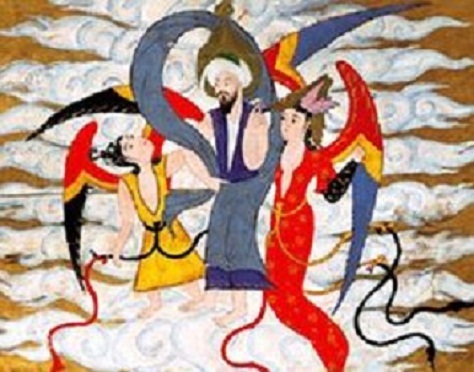
Night Journey, or Night Moves? Muhammad certainly has a
way wiith the ladies, er, houris....
Also, Necipoğlu mined Islamic pilgrimage guides—Arab, Ottoman Turkish and even
Persian—from the ninth through the 16th centuries AD for how they viewed the structural layout of
the Temple Mount. Many of them play up the eschatological meaning of the various edifices on the area around
the Dome of the Rock and al-Aqsa Mosque, as well as the surrounding topography; for example, the “Straight
Bridge” (sirat al-mustaqim) which “is visualized…as leading from the Mount of Olives to the Haram
al-Sharif” simultaneously “evokes the ‘straight path’ repeatedly mentioned in the Qur’an….”
(p. 77). In sum, the Dome of the Rock and Chain, and “the signs of the Hour mapped onto the surrounding
complex are only reminders and precursors of their real versions, a preview of things to come.” (p. 79).
Overall, says Necipoğlu, the Dome of the Rock in Islamic thought “salutes the end of time….”
(p. 81).
How the 1.3 million Muslims in Israel feel about the eschatological heritage of al-Haram al-Sharif—or
even whether they are aware of it—is beyond my ken; but it is noteworthy that in the bookstores of the Old City I found
five books on the Mahdi and the Muslim End of Time, four of which I purchased and plan to read (the other one was too thick
and expensive to buy and cart back home): 1) Ahdath al-Kafiyah wa-Fitan Akhar al-Zaman (“Traditions of Secrecy
and the Conflicts of the End of Time”), Cairo, 2012; 2) Nihaya al-`Alam: Ashrat al-Sa`ah al-Sughra
wa-al-Kubra (“The End of the World: Minor and Major Signs of the Hour,” Riyadh, 2010; 3) al-Qawl al-Sunni
fi Fitnah al-Dajjal wa-Zuhur al-Mahdi (“The Sunni Doctrines on the Conflict of the the Dajjal and the Appearance
of the Mahdi,” Cairo, 2011; and Ashrat al-Sa`ah wa-al-Fitan al-Malahim (“Signs of the Hour and the Conflicts
and the Epic Battles,” Gaza, 2012. Cairo, along with Beirut, is one of the major Arabic-language
publishing venues, so I assign no great import to Islamic eschatological works published there. However,
the publication of any work on this topic in the Kingdom of Saudi Arabia is striking, considering how much the Saudis fear
a repeat of the regime-threatening attempted Mahdist coup of 1979; and a publisher in Palestinian Gaza putting out a book
stirring the Islamic eschatological pot may well indicate that the Palestianian Muslims are ready for apocalyptic battle with
the Israelis—or, conversely, that they are ready to throw in the kaffiyeh on their own human efforts and, rather, just
wait for the Mahdi to come smite their oppressors.
Muslim eschatological fervor is boiling over in nearby Syria, as I analyzed on this site in September, 2013. The extent to which
Muslims in Israel are aware of, and inflamed by, this is unknown; what is known is that Damascus and Jersualem are much more
prominent in Islamic traditions (both Sunni and Shi`i) about the coming of the Mahdi and the subsequent eschatological events
than are Mecca and Medina. Therefore, it would behoove Western geopolitical and intelligence analysts—both
in and out of government—to put some effort into studying this topic, rather than relegating it to
the theater of the absurd or myopically obsessing over what Evangelical Christians think about the end of the world. I
would also add that the historical eschatological significance of Jersualem to Muslims is a major argument against
the thesis that the Iranian regime wants nuclear weapons in order to destroy Israel (I have already argued at length elsewhere that this charge little accords with Twelver Shi`i doctrines): Islam’s third-holiest
site is that religion’s most important eschatological locale, and no one is more respectful of such traditions than
the ayatollahs in Qom and Tehran. Thus, if al-Quds is nuked or even contaminated with fall-out from
a bomb on Tel Aviv, the Mahdi and Allah will not only be displeased but unable to stage the eschatological denouement. The
presence of the Domes of the Rock and Chain in Jerusalem is thus, in my studied opinion, and even greater deterrent to Islamic
nuclear attack on that city than is Israel's more prosaic Iron Dome anti-missile system.
1:48 pm est
|
|
|
|
| Jamkaran Mosque near Qom, Iran (during my trip there Aug. 2008) |
|
|
|
